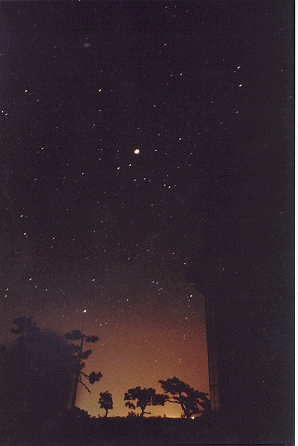Light Pollution and the Guillermo Haro Astrophysics Observatory
Light pollution is a clear example of the manner in which we coexist with many forms of pollution and tolerate them to the point where we no longer notice them. Almost everyone in the city is aware that it’s impossible to appreciate the beauty of the night sky, but hardly anybody realizes that it is pollution and that we can reduce it considerably. This without mentioning the adverse effect urban lighting has on nocturnal animal’s habitat.
Fortunately, awareness is growing on this issue and its adverse effects in the study of the Universe, and there are also ways to reduce it. In July, 1992, UNESCO announced the Declaration on the Reduction of Adverse Environmental Impacts on Astronomy. Astronomers have also started groups like the Dark Sky Association Some cities, like Tucson for example, have begun using better urban lighting that not only benefits neighboring observatories but also the people of Tucson, they now have better, cost and energy efficient lighting.
Light pollution is visible even at great distances, today, it is very difficult to find a spot where city lights cannot be seen. Locations for a professional astronomical observatory are rare these days, because they do not have the required darkness, even established observatories frequently face the growing problem that is light pollution.
The Guillermo Haro Astrophysics Observatory (OAGH) is located 13 KM from the city of Cananea, which is relatively small. Its reflection in the sky can be seen in the following photograph taken in direction to Cananea from the OAGH with an Ektar ASA 1000 film mounted on a Pentax SP1000 camera. The picture was taken in late 1996 or in early 1997; it shows a brighter and more extended halo than what is seen with the naked eye.

The image below shows a montage of three photographs taken in Cananea city at the same time the one before was shot. Cananea, located one thousand meters below the site of the observatory expands about twenty degrees below the horizon towards the southeast. According to the preliminary results of the INEGI 2000 census, the municipality of Cananea has a population of 32,074.
In mid 1996 it had 1,800 illumination lamps, out of which only about a thousand worked. In 1997, the larger part of the mercury lamps (white light in the picture), where replaced with high pressure sodium lamps. In late 1997, the Mexican Mining Company of Cananea closed all operations which included the chimney that emitted smoke (with an acid smell) towards the city, as can be seen in the right side of the picture. Closure of this chimney has been highly beneficial for the health of people in Cananea.

Rough estimates (deduced with the naked eye by distance and number of lamps) set Cananea’s integrated magnitude at –7. The data available on sky brightness suggest that the sky of the OAGH site has a brightness excess with a magnitude per second of 1 mag/arcsec, with a 0.7 and 0.5 mag/arcsec difference, in B and V colors respectively, between the direction towards and opposite Cananea. We expect to improve this quantification in the near future, using the MEADE 16-inch telescope.
Declaration on the Reduction of Adverse Environmental Impacts on Astronomy
Participants in the IAU/ICSU/UNESCO Exposition on the Adverse Environmental Impacts on Astronomy have declared that the night sky and its beautiful stars, not only have a message about our place in the Universe, they are also a precious treasure for humanity, from which we obtain knowledge and comprehension of our origins and destiny. We also state that Astronomy is a fundamental, valuable and accessible Science.
However, our civilization which nurtures our Science is producing a negative environment and has created a desperate situation for the Astronomical Sciences. The sky, which has served as inspiration for all humanity has been damaged to the point where it will be foreign to new generations. An essential element for our civilization and culture is being rapidly lost and this loss will affect all the world’s countries.
We believe this is a global problem that must be treated accordingly by intergovernmental organizations, we request that the UNESCO and the ICSU (International Council of Scientific Unions), use all available means for providing Astronomy with assistance. This means that all sites for astronomical observatories must be preserved, with the added protection of naming them World Heritage Sites.
Member states must provide legal protection to their main observatories in order to preserve natural observing conditions, they must also urge spatial agencies and the United Nations Committee on the Peaceful Uses of Outer Space to reach agreements concerning the levels of space debris and find feasible procedures for the elimination of threats posed to astronomical observation. Other governmental, intergovernmental and nongovernmental organizations, whose activities might affect the astronomical environment, must focus on ensuring their impact is minimal and must pursue paths of research for potential legal protection in an international level.
Address: Luis Enrique Erro # 1, Tonantzintla, Puebla, Mexico ZIP Code. 72840 Tel: (222) 266.31.00 Contact: difusion@inaoep.mx
This work is licensed under a Creative Commons License Attribution-Noncommercial-No Derivative Works 2.5 Mexico.


